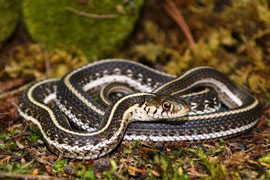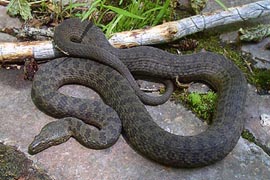Cronkite News has moved to a new home at cronkitenews.azpbs.org. Use this site to search archives from 2011 to May 2015. You can search the new site for current stories.
Feds declare New Mexico, Arizona gartersnakes threatened species
WASHINGTON – The U.S. Fish and Wildlife Service granted threatened species status Monday to northern Mexican and narrow-headed gartersnakes, saying the animals in Arizona and New Mexico could otherwise be in danger of extinction.
The protection stopped short of the stricter endangered species status for the snakes, but conservationists and government officials said the threatened designation will provide protection while giving them the flexibility in setting regulations.
“Protecting these snakes under the Endangered Species Act really is important to getting them on the path back to recovery,” said Collette Adkins Giese, the reptile and amphibian staff attorney for the Center for Biological Diversity, which has been pushing for the designation.
The two non-venomous snakes reside in rivers and other aquatic habitats, with a range that includes much of Arizona and parts of New Mexico and northern Mexico. Their numbers have fallen sharply from loss of habitat and competition with nonnative species, officials said.
One challenge in issuing the declaration is the difficulty in getting information on the snakes, said Jeff Servoss, a biologist in Arizona for the Fish and Wildlife Service. Because their range includes tribal land and parts of Mexico, it can be difficult to gain access and gather information.
“We don’t have the resolution of field data to get the comfort level required to call something endangered,” Servoss said.
But he hopes the threatened listing can serve as a “wakeup call” on the problem of nonnative species in the Southwest.
The threatened status officially takes effect in 30 days. At that point, Adkins Giese said, it will be illegal to collect or kill the snakes, among other protections.
Collection was already banned under Arizona law, but the federal listing means any time there is an activity that affects the snakes, it will now have to be reviewed by the service, Servoss said.
“It forces people to think about what they’re doing and how it affects the species,” he said.
Servoss called the lesser status of threatened species a “perk,” because it lets the service “get creative in targeting opportunities for conservation.”
In this case, that means a special rule that exempts operation and maintenance of livestock tanks on private, state and tribal lands, allowing landowners to construct and maintain the tanks without violating federal regulations.
Adkins Giese welcomed the exception for livestock tanks, which she called basically “little manmade ponds” that can provide habitats for the snakes and their prey, she said.
“The Fish and Wildlife Service doesn’t want to deter people from putting out these tanks that actually can be helpful to the snakes,” she said.
In the past, the center has fought such special rules, but has no plans to challenge this “quite narrow” rule that benefits the snakes, Adkins Giese said.
The center said the gartersnake ruling is the latest in a series of decisions that stemmed from a 2011 settlement of its lawsuit to force action on endangered species petitions. Since then, the center said in a news release, 120 species have gained protection under the act, including the gartersnakes, and another 23 have been proposed for protection.
“The Endangered Species Act is the most powerful tool we have to protecting our nation’s wildlife,” Adkins Giese said.








